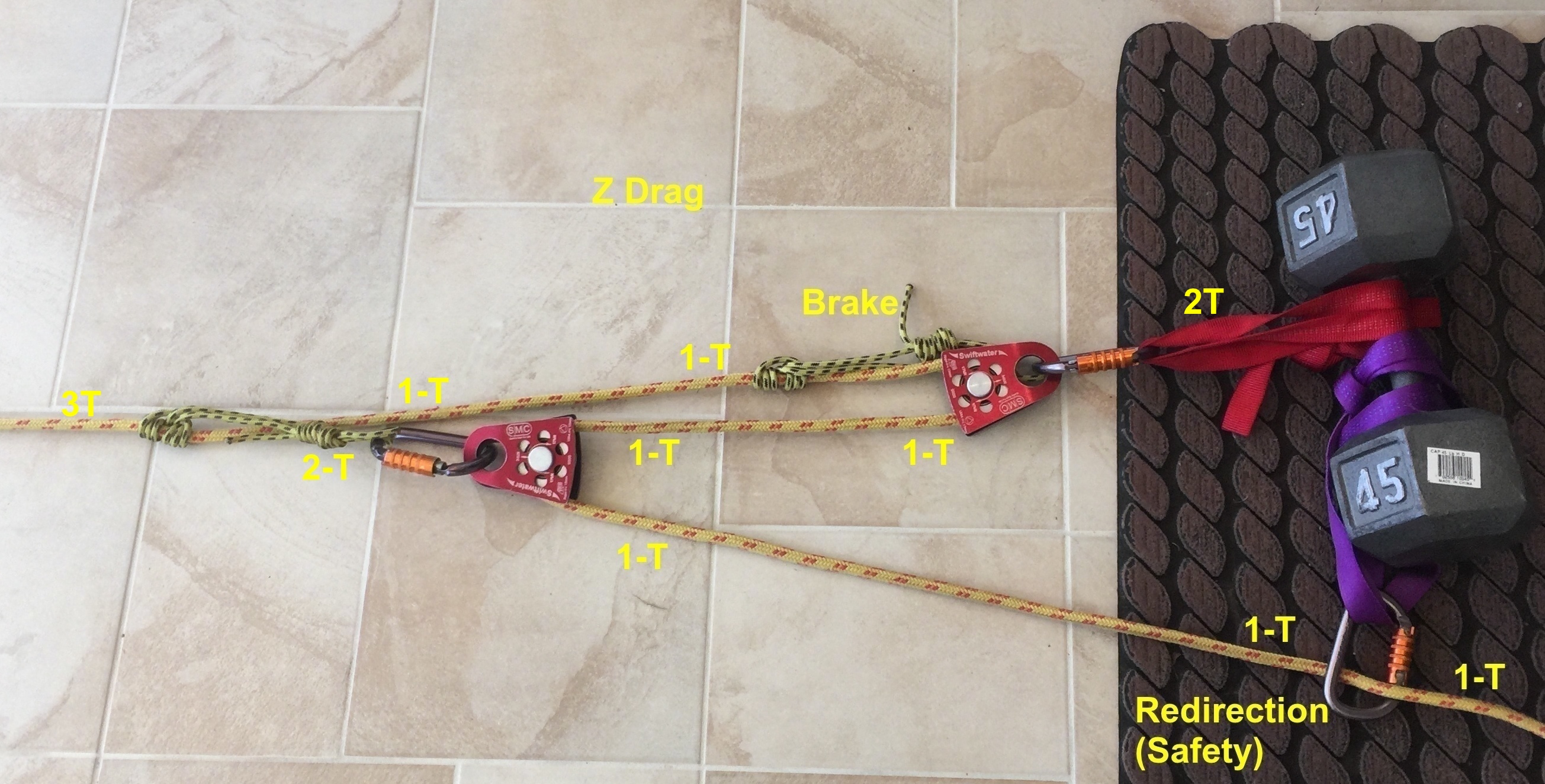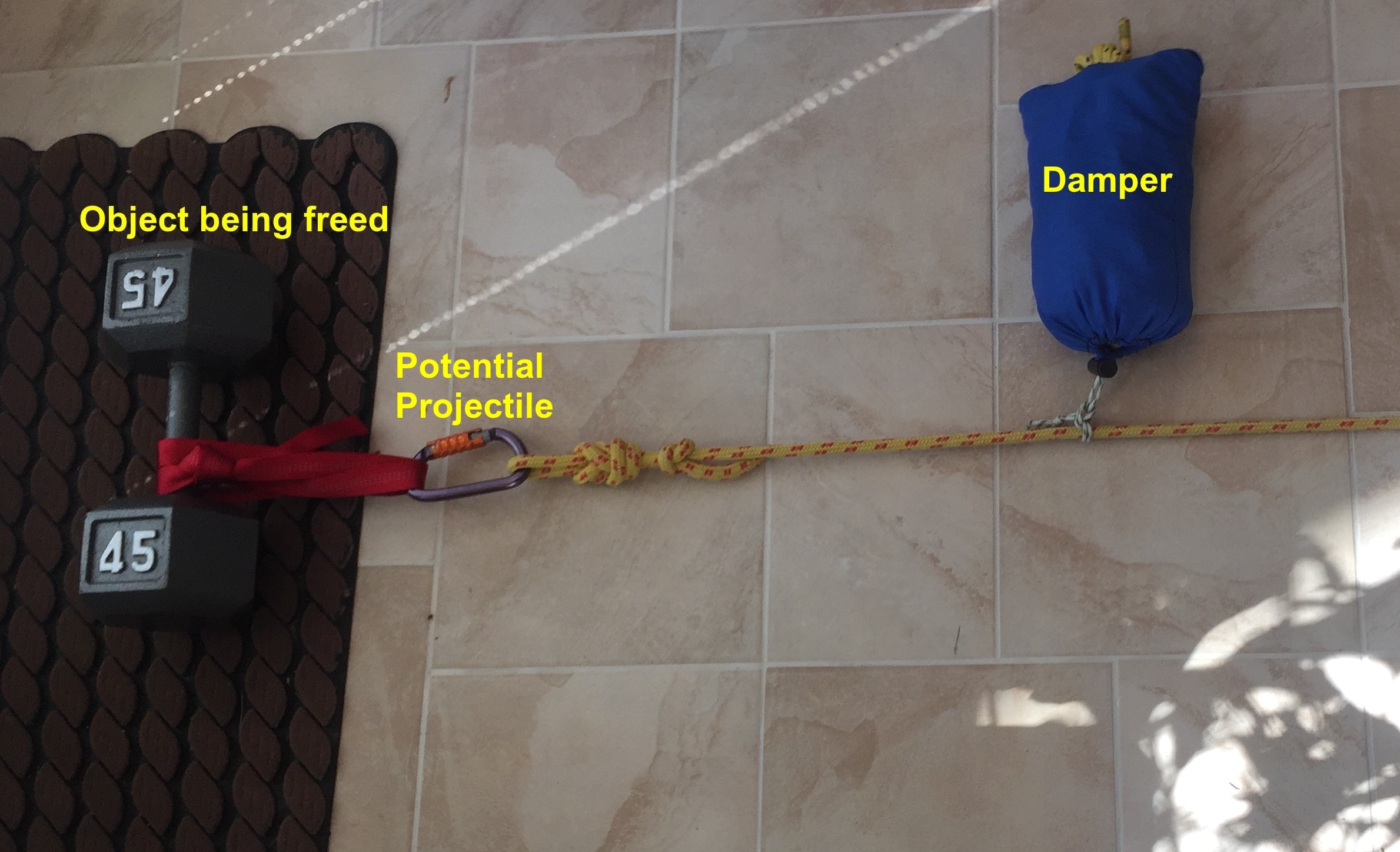Discuss and demonstrate the importance of simplicity and rescue safety in mechanical advantage systems
In general, the greater the complexity - the greater chance for errors. When working with significant forces as described above, set-up errors can cause a rope to snap or send an attachment like a carabineer or pulley flying like a bullet. Getting hit by a snapped line or carabineer can cause serious injury. You really need to evaluate the strength of your rope and anchors to ensure nothing can break.
The Z Drag isn't something we practice very much so it can take some time to figure out. It also takes time to locate and set-up suitable anchors for this system. Add additional time for safety dampers and brakes and 20 - 30 minutes can go by very quickly. Compare this to simpler methods like the Armstrong method, vector pull, and simple turning - all of which are safer and much faster.
For these reasons, avoid heavy mechanical advantage systems when rescuing a pinned boater. Often time is of the essence for a trapped paddler. If possible, extract the boater and deal with boat recovery when everyone has had a chance to rest.
3:1 (Z-drag)
 Most SWR classes teach the Z-Drag mechanical advantage system. The Z-Drag is confusing to many but many of us use this system every time we tie our boats to our cars with a Truckers Hitch or cinch down on a cam strap. The hitch or cam becomes our traveling pulley. Friction greatly reduces the effectiveness of this rigging - count on only a 2:1 advantage when using a carabineer as your traveling pulley. When purchasing a pulley, you need at least a 4:1 ratio between the rope diameter and the bend caused by the pulley to maintain rope strength. For our purposes, a 2" pulley is just about the right size. For prussic line diameter, 5 mm - 7 mm works well with 3/8" line - 7 mm is best. The following paper does a great job at explaining the various mechanical advantage systems: Understanding Mechanical Advantage Systems. If you want to see a simple Z Drag in action, check out the following video: Z-Drag in Action.
Most SWR classes teach the Z-Drag mechanical advantage system. The Z-Drag is confusing to many but many of us use this system every time we tie our boats to our cars with a Truckers Hitch or cinch down on a cam strap. The hitch or cam becomes our traveling pulley. Friction greatly reduces the effectiveness of this rigging - count on only a 2:1 advantage when using a carabineer as your traveling pulley. When purchasing a pulley, you need at least a 4:1 ratio between the rope diameter and the bend caused by the pulley to maintain rope strength. For our purposes, a 2" pulley is just about the right size. For prussic line diameter, 5 mm - 7 mm works well with 3/8" line - 7 mm is best. The following paper does a great job at explaining the various mechanical advantage systems: Understanding Mechanical Advantage Systems. If you want to see a simple Z Drag in action, check out the following video: Z-Drag in Action.
Take a closer look at the picture above. You will notice an extra Prusik on the load bearing rope back to the tree. This is a brake and enables you to ease off the pull line and still hold the load for awhile. You will probably need to advance the prusik knot as more rope is pulled else it will get caught in the pulley.
 Another safety device is dampers. The following video uses a dynamometer to calculate the force on the load bearing end of a mechanical advantage system. This video also demonstrates the use of dampers to prevent the system from hurling rope and gear under force. The blanket adds some weight and quickly arrests the loosened gear: Mech Advantage with safety dampers
Another safety device is dampers. The following video uses a dynamometer to calculate the force on the load bearing end of a mechanical advantage system. This video also demonstrates the use of dampers to prevent the system from hurling rope and gear under force. The blanket adds some weight and quickly arrests the loosened gear: Mech Advantage with safety dampers
In this next video, we intentionally pulled a Z Drag to failure to demonstrate what happens. This is also a great example of the use of a directional change to keep us out of the line of fire: Z Drag with Directional Change.
Vector pull standard method and progressive vector
This is a very deceptive mechanical advantage system and extremely easy to set up. Picture two really strong persons pulling on a taught line. Now, take your typical 98 pound weakling and have them pull in the center of that line. With little force, that 98 pound weakling can drag the other two together. The Vector Pull provides the greatest strength when starting at 180°. You lose all mechanical advantage at 45°. The Vector Pull is often used to assist a belaying rescuer pulling a boat and paddler into shore - simply work your way down the throw rope. One item you need to consider is anchor strength. Many anchors are very stable in one direction only. A Vector Pull typically moves the angle of pull and this may loosen your anchor system - be careful.
10 boy scouts
The Armstrong (AKA: 10 Boy Scouts) method can produce a fair amount of force and is very easy to set-up. If you have enough manpower, you probably don't need to set up anchors and you can use the full length of the rope. This approach mimics a tug of war and is often used in conjunction with someone turning the boat to have water pressure assist. It typically takes just a few minutes to set-up and you have fine control on how much pressure is applied. This method is an excellent choice for extracting a pinned boater and lowering or raising a rescuer in a vertical rescue.
Page 2 of 3
